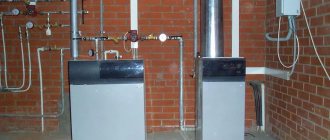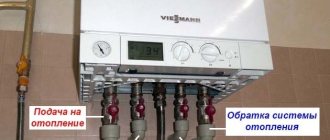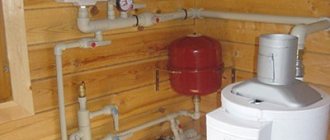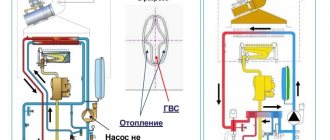Gas units are not intended for location in enclosed spaces. It is almost impossible to obtain official approval for installation. Why do gas workers refuse, what motivates the ban, what documents are they referring to and what to do in this case? Find out the answers to these questions from this article.
- 2 Regulatory standards
- 3 SNiP regulations, comments on standards
3.1 What requirements must a bathroom meet?
Is it possible to install a gas boiler in a bathroom?
In Soviet times, this arrangement of speakers was practiced in five-story buildings. Technical standards in the USSR allowed this. This arrangement made sense - while bathing, a person could regulate the heating temperature of the water. In addition, bulky equipment did not spoil the interior of the kitchen.
Modern standards prohibit installing or hanging boilers in bathrooms. The main reason is the large number of cases of carbon monoxide poisoning. There is no direct ban, but standards for compliance of premises have been stated. The bathroom and toilet do not meet these requirements. Therefore, if it is possible to place the device in another room, give up the idea of unauthorized mounting of the device.
Use of liquefied gas
“Problems” with project documentation are not required in the case of using not natural, but liquefied “ballooned” gas. However, in this case the column must have an appropriate design - burners for natural and liquefied gas have different diameters of injector nozzles. Although such equipment is produced by many manufacturers, it is quite rare on sale and is demanding in terms of gas quality.
In any case, the wall where the speaker is installed must be strong and non-flammable - if it is made of plasterboard, then a “mortgage” for attaching the heater, made of wood or metal, must be mounted in it in advance.
Regulatory Standards
The story of obtaining documentary consent to install a gas boiler in a bathroom is complicated by confusion with permitting papers. Current regulations do not contain specific information about whether it is feasible to place the device in a bathroom.
Gas company employees refuse, citing SNiP 2-04 . The ban is clearly regulated there.
However, according to the Decree of the State Construction Committee, these documents have lost their legal force. The result is that difficulties and misunderstandings arise. To get approval from gas workers, you need to collect a bunch of papers. Unauthorized connection is fraught with big problems.
Video description
How to install a chimney pipe, see the following video:
Connecting a ceramic chimney
Ceramic chimneys themselves are practically eternal, but since this is a rather fragile material, you need to clearly understand how to correctly connect (docking) the metal part of the chimney and the ceramic one.
Docking can only be done in two ways:
For smoke - a metal pipe is inserted into a ceramic
It is important to remember here that the outer diameter of the metal pipe should be smaller than that of the ceramic one. Since the thermal expansion of metal is much greater than that of ceramics, otherwise the steel pipe, when heated, will simply rupture the ceramic one.
For condensate, a metal pipe is placed over a ceramic pipe.
For both methods, specialists use special adapters, which, on one side, are equipped with a gasket for contact with a metal pipe, and on the other, which contacts directly with the chimney, are wrapped in a ceramic cord.
The joining should be carried out through a single-wall pipe - it has a higher heat transfer coefficient. This means that the smoke will have time to cool down a little by the time it reaches the adapter, which ultimately extends the service life of all materials.
SNiP regulations, comments on standards
The procedure for installing equipment in residential spaces is regulated by SNiP. The document says: it is not recommended to hang a gas boiler in bathrooms and toilets - provision 2-04 SNiP.
The paradox is that this standard is being canceled by another document - Gosstroy Resolution No. 163. Together with it, the Gas Distribution Code SP 62-13330 came into force. There is no information about the ban at all. The document defines the general conditions that apply to the premises where the equipment is planned to be installed. Let us consider them in more detail in relation to a specific space.
What requirements must a bathroom meet?
Standard placement principles:
- useful area - less than 7 m, total - from 9 - for gas equipment with an open burner. For closed models - from 8 squares;
- there is a supply and exhaust;
- window - its parameters depend on the energy consumed by the equipment. If we are talking about an apartment building, the standard requirement is an opening of no more than 1.7 square meters;
- Leave a space of 2-3 centimeters between the door and the frame. Experts recommend installing a ventilation grill into this space at the bottom of the door;
- the distance from the wall opposite is 1 meter - this is necessary for uniform circulation of air flow.
From the listed nuances it is clear that locating the boiler in the toilet is impossible precisely because of the inadequacy of the room - a small square area, no natural light.
Installation: recommendations and diagrams, main stages of chimney installation
Chimney installation is divided into several stages - preparatory work, installation itself, then connection, startup and, if necessary, debugging of the entire system.
General requirements
When several heat-generating installations are combined, each of them creates its own chimney. In exceptional cases, a tie-in to a common chimney well is allowed, but a difference in height of at least one meter must be maintained.
First, the chimney parameters are designed and calculated, which are based on the recommendations of gas boiler manufacturers.
When summing up the calculated result, the internal cross-section of the pipe cannot be less than the diameter of the boiler outlet pipe. And according to testing according to NPB-98 (fire safety standards), the initial speed of the natural gas flow should be 6-10 m/sec. And besides, the cross-section of such a channel must correspond to the overall performance of the unit (8 cm2 per 1 kW of power).
Installation steps
Chimneys for gas boilers are mounted outside (attached system) and inside the building. The simplest is the installation of the outer pipe.
Installation of an external chimneySource astroyresurs.ru
Installing a chimney on a wall-mounted boiler is done as follows:
- A hole is cut in the wall. Then a piece of pipe is inserted into it.
- The vertical riser is assembled.
- The joints are sealed with a fireproof mixture.
- Fixed with wall brackets.
- An umbrella protecting from precipitation is fixed on top.
- An anti-corrosion coating is applied if the pipe is made of metal.
Proper installation of the chimney guarantees its impermeability, good draft, and does not allow soot to accumulate. Installation performed by specialists will significantly reduce the cost of maintaining this system.
When constructing an opening for a pipe in the roof of a house, special boxes with aprons are used. In this case, the design as a whole is influenced by such factors as:
- The material from which the pipe is made.
- External design of the chimney.
- Type of roof covering.
The main factor influencing the choice of design is the temperature of the gas that passes through the pipe. At the same time, according to standards, the distance between the chimney pipe and combustible materials must be at least 150 mm. The most advanced assembly system is considered to be in segments, where all elements are assembled using the cold forming method.
What is the penalty for installing a gas boiler in a bathroom?
The reasons why it is prohibited to install gas equipment seem unfounded to many. But the punishment for unauthorized installation is quite serious. Self-installation means, at a minimum, penalties and forced removal.
Unscrupulous users circumvent the law. They order design papers in such a way that the premises are listed as a boiler room. The bathroom, accordingly, is excluded from the project plan. The gas unit is installed and connected. After this, all plumbing returns to its place. The apartment owner happily forgets about troubles and problems with documents.
A year later, when gas workers check the operation of the boiler, violations will come to light. The employee will draw up a report and issue a fine, the minimum amount of which is 45,000 rubles.
Legal information! If the illegal installation of gas equipment caused damage to someone else’s property or resulted in the loss of human health or life, criminal liability and a real sentence of 2 to 5 years arise.
Advice! If you still decide to install a boiler in the toilet, do it legally. Since regulatory documents do not strictly prohibit installation, proceed as follows:
- submit an application to the head of the gas organization with a request to install a boiler in the bathroom or toilet;
- motivate your demand, formulate the reasons why you insist on installation in this location;
- attach supporting documents;
- If the arguments were not enough, write a statement of claim to the court. There is a chance that the decision will be made in favor of the plaintiff.
Is it possible to install a shower, toilet and washing machine in the boiler room?
Is it possible to install a gas boiler in the same room as a shower stall?
author: Sergey
Is it possible to install a shower stall in the same room with a double-circuit gas boiler in a private house, subject to all safety rules for operating gas equipment? If not, what is the reason for this?
Best regards, Victor Danilchenko
It will be better if the booth is installed at a distance of at least a meter from the boiler. This way the gas workers will be calm, and you will be safer. You can also make a partition between the boiler and the cabin. But in any case, you need to consult with gas workers.
Is it possible to install a shower stall in the same room as a gas boiler?
Good afternoon Please tell me, is it possible to install a shower stall in a room where a gas boiler is located?
Is it possible to install a shower, toilet and washing machine in the boiler room?
Hello. Tell me, is it possible to install a shower, toilet, and washing machine in a boiler room of 9 m2, 25 m3? Beretta boiler 24 kW, water heater 180 l?
Theoretically possible, practically difficult. There are many regulations governing the installation of gas equipment. These are SNiPs 41-01-2003, 2.04.08-87, 31-02-2001, 42-01-2002, SP 42-101-2003 and a number of departmental documents. Nowhere is there a direct prohibition on installing a gas heat generator in a combined bathroom, but this is what a room with a shower, washbasin and toilet should be called. You definitely cannot place the boiler only in living rooms. Allowed in kitchens and separate rooms not located in the basement and meeting SNiP standards.
The basic requirements for installing a boiler of the power you specified are:
The total volume of the room must be at least 7.5 m3 (for the kitchen 13.5 m3); Ceiling height from 2 meters; The presence of natural exhaust and inflow, providing three air exchanges within an hour; The room must have a window with a net glazing area of at least 0.8 m2 with a standard glass thickness of 4 mm. It is necessary to ensure that combustion products are removed from the boiler in accordance with building codes and manufacturer's requirements.
But there are additional requirements.
All heating equipment placed in a room with high humidity (namely, a shower room) must have an anti-corrosion design. Let's say you convinced the relevant authorities of this. Let's say the passports of your boiler, pump and voltage stabilizer indicate that the electrical equipment has an increased class of protection against moisture, not lower than IP 44 . Let's say you managed to maintain all the necessary distances from plumbing to heat-generating appliances, this is at least 60 cm. There is still the problem of electrical outlets: according to existing standards, there should not be any in the bathroom. You can connect the devices directly or install special waterproof sockets, and route the wiring through sealed cuffs . Theoretically, if these conditions are met, it is allowed to combine a furnace room and a bathroom. Although, from a technical point of view, this is really not the best solution. In addition to the boiler itself, you will also have to install a boiler, pumping group, pipelines and other equipment. Will it be possible to rationally place all this in the bathroom?
In practice, the decision depends on how your local gas authorities interpret the concept of “separate room” . From the point of view of construction terminology, this is any room separated by a door from the common space. From the point of view of gas workers, this is a room intended only for the installation of heating equipment. They are calm about placing a washbasin in the furnace room, they rarely object to a washing machine, but, as a rule, they are categorically against the presence of a shower, bath, steam room, or complex electrical equipment in the boiler room. In addition, gas service specialists are right: from a technical point of view, this is really not the best solution. Domestic standards directly allow the placement of a gas boiler in the kitchen. This may be the best solution for you. Again, theoretically, one can argue with this approach. There are rare cases where developers managed to implement such a solution, proving that there are no direct prohibitions on installing a gas boiler in the bathroom. However, if you are not ready to get involved in long disputes, bother with additional documents, coordinate technical details and their implementation with biased inspectors of gas, fire and energy services, we advise you to think about an alternative solution. You can get more detailed information first-hand from your regional gas service.
Gas workers appeal only with fears for our lives in the event of a gas leak, and they do not have any SNiPs about the placement of shower cabins in furnace rooms.
9.32 The installation of water heaters, heating boilers and heating devices should be provided in kitchens and furnaces that meet the requirements of 9.37 and 9.38. Installation of these devices in bathrooms is not allowed .
And yet, according to our passport, this room is not a bathroom, but a furnace room, which meets the requirements of 9.37 and 9.38. So, nowhere in these requirements is there a ban on installing showers, toilets and sinks in furnace rooms. Or am I not right?
That is, if a gas boiler is made “of anti-corrosion materials or with protective coatings against corrosion,” then it can even be installed in a bathroom? I’ll try to “fight” with the designers.
· internal gas pipelines and gas equipment of industrial, administrative, public and domestic buildings where gas is used for food preparation or laboratory purposes;
· autonomous heating and hot water supply systems for administrative, public and domestic buildings with boilers and heat generators, without generating thermal energy for production purposes and (or) providing services with the total thermal power of installed equipment less than 100 kW.
Source
Which boiler can be installed in a bathroom?
If you decide to install a boiler in a toilet, choose the equipment correctly. The Code of Practice dated January 2003 does not prohibit the installation of gas units in the bathrooms of apartment buildings that are not connected to an individual or central heating system. The main condition is the closed type of the boiler chamber.
Advantages of gas heating
Everyone knows that residents of apartment buildings in the city pay much more for heating their homes than people living in country houses. What is this connected with?
First of all, with the fact that prices for heating and hot water are too high, and sometimes simply unreasonably high. At the same time, the temperature in the apartment often does not correspond to the norm, so there cannot be any pleasure from such a stay.
To solve the problem, some townspeople install an autonomous heating system with a gas boiler, the advantages of which are obvious:
- Autonomy - independence from hot water suppliers. And gas shortages are extremely rare.
- Creating a comfortable level of heat in rooms with the ability to regulate it.
- In addition to heating the home, it is possible to use hot water.
- Significant financial savings when paying for housing and communal services.
- Creating coziness and comfort regardless of the beginning of the heating season - at any time, in cold weather, in autumn and spring, you can independently turn on the heating of the apartment.
Official conditions for the location of gas water heaters in the bathroom
Why do many people want to hang a boiler in the bathroom? This location has a number of advantages:
- compactness;
- the device does not spoil the interior of the kitchen, does not take up additional space;
- hot water flows directly to its destination - to the shower and sink.
Installation rules:
- redesign the premises;
- record changes in technical documentation;
- register the boiler with the gas company. To do this, reformat the room in the BTI - give it the status of a storage room;
- Call a specialist - a representative of the gas service and connect the equipment.
Wrong decisions
The most common mistake is the lack of a boiler room in the house. They try to install the equipment under the stairs or in another corner. This is not only inconvenient, but also dangerous.
Important! The boiler, boiler, many pipes, expansion tanks must always be freely accessible to adults and hidden from children.
A particularly big problem arises if it becomes possible to install main gas. That is why it is worth adding into the project a room of at least 5 m² at the construction stage, so as not to create inconvenience in the future.
Types of equipment
There are two types of boilers:
- storage water heater;
- flow boiler.
Storage type equipment is a boiler that is similar to a boiler. The device is equipped with a reservoir of various capacities. Storage elements are placed inside the tank. As hot water is consumed from the tank, the tank is filled with tap water. The automatic control panel allows you to regulate the heating temperature, prevents overheating and boiling of the liquid in the tank. Such boilers are produced in two modifications:
- hanging - they are mounted on the wall;
- stationary - installed on the floor.
A flow-through boiler has a more complex design. The column heats up quickly thanks to the heat exchanger. The liquid will become hot in 7-10 minutes. The main advantages of flow-through boilers:
- efficiency;
- ease of operation;
- reliability of the unit.
In addition, such devices have an automatic ignition system. This guarantees the safety of using the equipment - gas vapors are burned in full.
As practice shows, flow-type boilers are more popular. The device has small parameters, it is convenient to place it in small rooms. At the same time, the boiler’s power is enough for a family of 5 people.
Entrance
It is most convenient to get into the boiler room through the interior door from the hall or corridor. This option will be much better than a separate entrance from the street.
The advantages of this solution are:
- You don’t have to spend money on buying a second warm door to enter. The price of the latter is higher than the cost of a regular interior door.
- When you need to get into the boiler room, you will not need to go outside. Housewives will especially appreciate this point, because wet cleaning in the boiler room is required with the same frequency as in the rest of the building.
- There is no need to expand the porch or make a canopy over the door to the boiler room. When entering from the street, you will inevitably have to spend money on the construction of such structures.
Kitchen
The height of the room where the heating unit and cooking stove are installed must be at least 2.5 meters.
The room volume indicators vary within 15 cubic meters + 0.2 cubic meters, which are calculated for each kilowatt of gas boiler power, > 60 kW.
situation in the gas boiler room
requirements for a gas boiler room
The room must have sufficient ventilation. This includes the gas chimney and vents.
The kitchen should have a fairly wide window with a window opening outwards. The glazing area is three hundredths of a square per cubic meter of room volume. For a room occupying a volume of 16 cubic meters. m, windows should be 0.48 sq. meters. That is, in such a room, a window with dimensions of 0.5 m in width and 1 meter in height is acceptable (do not forget about the window opening outward).
A thin metal sheet or foil should be attached to the ceiling above the installed gas stove.
There should be a sufficient gap or additional ventilation at the bottom of the door.
The requirements for a gas boiler room located in the kitchen are not much different from the conditions in other isolated rooms of the house without a stove. Additionally, it should be taken into account that placement in a separate room provides for the separation of the boiler room from adjacent rooms by walls with the required fire resistance limit (not
Conclusion
When arranging your boiler room, it is best to consult with a knowledgeable gas service specialist in your region. Because, as inspectors checking the installation of heating equipment, they can find any reason to draw up an order with aggravating conditions or a fine. It is better to comply with all instructions from gas workers and similar services in advance. You can get acquainted with the opinions of your neighbors on equipping a room with a boiler, and get acquainted with information on the Internet. Then you will never pay extra money to representatives of the gas or chimney and ventilation services for servicing chimneys and other “inventions” of enterprising workers of such services. If there are no conditions for installing floor-standing boilers, it is better to install wall-mounted boilers that do not require such stringent requirements regarding the premises. However, when installing suspended structures, special conditions are imposed on the distribution pipeline system, couplings and adapters.
Source Source https://septik.guru/vannaya-komnata-i-tualet/pochemu-nelzya-ustanavlivat-gazovyj-kotel-v-vannoj-komnate-pravila-i-prichiny-zapreta.html https://101studio.ru /kotly/mozhno-li-v-kotelnoj-postavit-stiralnuyu-mashinu.html
Follow the basic requirements for a gas boiler room!
Those people who are faced with issues of supplying gas to their home have to deal with various difficulties and obstacles from the gas service. The most important thing is that the legislation does not collect all the norms and requirements for equipping a boiler room in a private building in a separate document. Therefore, the country's gas producers can manipulate the requirements at their discretion, paying attention to some details and reducing their vigilance in other cases. But the basic requirements of gas workers in different regions are still largely similar. The requirements for a gas boiler room are aimed at complying with safety regulations for working with gas-powered heating appliances. They are aimed at minimizing losses from gas leaks and explosions.











